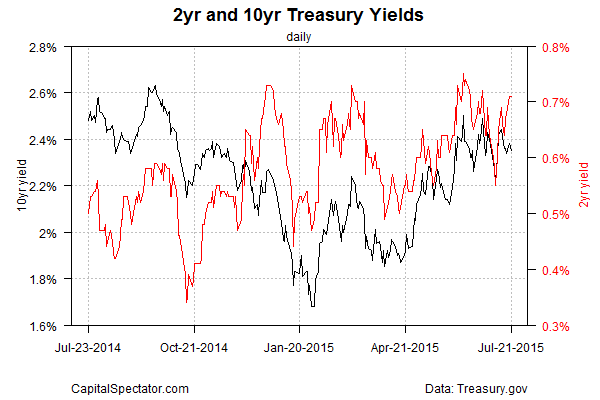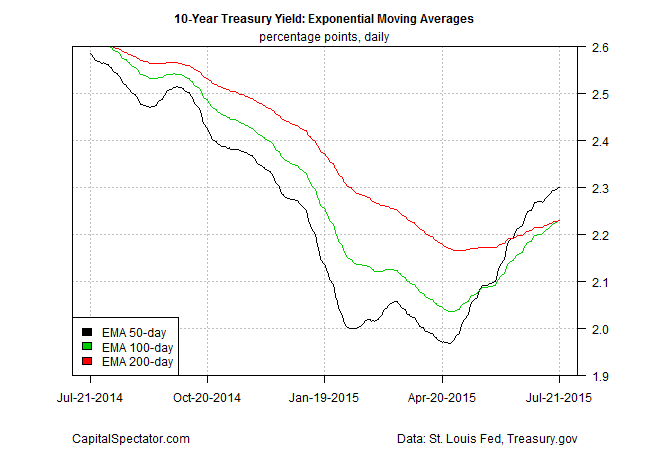Soft pricing in raw materials will likely delay a Fed rate hike for the US, opines Michael Hewson, chief market analyst at CMC Markets UK. “Given that weak commodity prices are likely to prompt a ripple-out disinflationary effect, it is hard to see how the Fed would even consider hiking rates against such a weak backdrop,” he told CNBC on Monday. But St. Louis Fed President James Bullard said this week that there’s “more than a 50% probability right now” that the central bank will raise the target rate at the monetary policy meeting scheduled for September 16-17.
Mr. Market seems inclined to side with Bullard’s outlook. The 2-Year Treasury yield—considered the most sensitive spot on the yield curve for rate expectations—is sticking close to four-year highs—0.71% as of July 21, based on Treasury.gov data.

The benchmark 10-Year yield has been somewhat softer lately, slipping to 2.35% yesterday (July 21). But that’s only modestly below the 2.50% mark set on June 10—the highest rate since last September. One or two better-than-expected economic updates could easily boost the rate so that it rivals the previous high.
Meanwhile, when we strip out the noise in the daily numbers, upward momentum is still bubbling in the key rates. The 2-year yield continues to show signs that it’s itching to go higher, based on exponential moving averages (EMAs).

And the 10-year yield’s recent bullish U-turn remains intact from a technical perspective.

It’s hardly a surprise that the market’s prone to price-in a rate hike for the near-term future. As recently as last week, Fed Chair Janet Yellen advised that the first round of monetary tightening since 2006 was on track for sometime in this year’s second half.
But how does that jibe with economic growth, which is still moderate at best? Second-quarter GDP, for instance, is projected to rise 2.4% (real seasonally adjusted annual rate), according to the Atlanta Fed’s GDPNow model as of July 17. That’s an encouraging improvement over Q1’s 0.2% decline, but a mid-2% growth rate is hardly a sign that the macro trend is strong, much less overheating.
Nonetheless, there’s a growing perception that the Fed is eager to get a rate hike on the books, if only as a symbolic effort after years of keeping the policy rate close to zero. Skeptics counter that wage growth is still too weak to warrant a hike. A fair point, although Yellen sees a stronger labor market ahead. Her upbeat outlook will be stress-tested when we see the next monthly profile on nonfarm payrolls for July, due on August 7. Meantime, the case for modest progress on the economic front remains in play, as implied by Mr. Market’s implied forecast via Treasury yields.
What could change this outlook? Disappointing economic numbers. The next potential for an attitude adjustment: Friday’s flash estimate for the US manufacturing sector via Markit’s purchasing managers index (PMI) for July. But the crowd’s expecting moderate if unspectacular growth to prevail. Econoday.com’s consensus forecast sees this month’s initial PMI reading ticking up to 53.7 from June’s 53.6.
In short, the case still looks reasonable for a near-term rate hike. It’s not overwhelmingly so, but short of surprisingly weak numbers in the days and weeks ahead, the crowd’s cautiously on board with the notion that the Fed’s about to squeeze policy, if only slightly.
